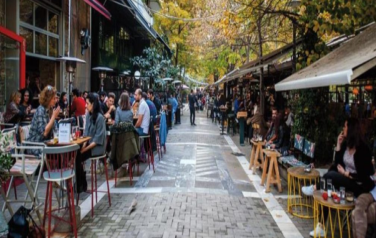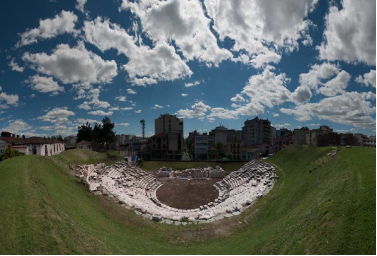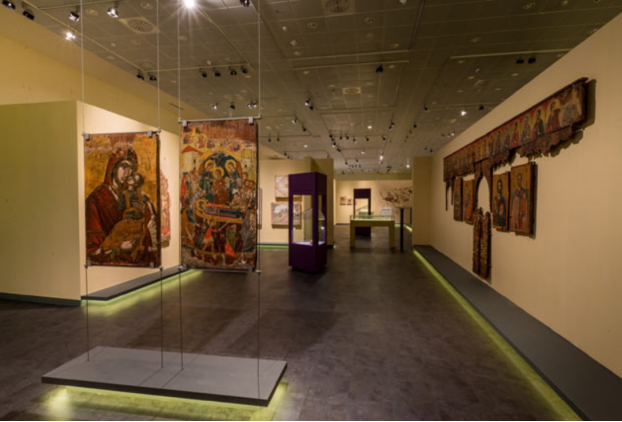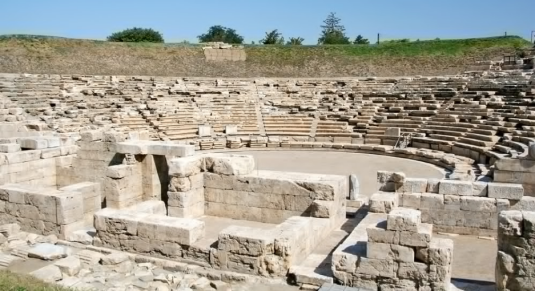Larissa, Larissa, Thessaly 作者: 来源: 发布时间:2021-05-18
I. Population, Area
Total Area: 335.98 km2
Elevation: 67 m (220 ft)
Municipal unit density: 1,200km2
Population: 284, 325 (2011)

II.Natural Geography
Larissa is the capital and largest city of the Thessaly region in Greece. It is the fourth-most populous city in Greece with a population of 144,651 according to the 2011 census (181,713 est. 2018). It is also capital of the Larissa regional unit. It is a principal agricultural centre and a national transport hub, linked by road and rail with the port of Volos, the cities of Thessaloniki and Athens. The municipality of Larissa has 162,591 inhabitants, while the regional unit of Larissa reached a population of 284,325 (in 2011).
Legend has it that Achilles was born here. Hippocrates, the "Father of Medicine", died here. Today, Larissa is an important commercial, transportation, educational, agricultural and industrial centre of Greece.
The climate of Larissa is semi-arid in the cool version but it is close to a hot summer Mediterranean climate (Csa). The winter is fairly mild, and some snowstorms may occur. The summer is particularly hot, and temperatures of 40 °C (104 °F) may occur. Thunderstorms or heavy rain may cause agricultural damage. Larissa receives 413 mm (16 in) of rain per year.
Larissa sits in the middle of the plain of Thessaly, with connections to Motorway A1 and national roads EO3 and EO6.
Larissa's Urban Bus System
Larissa's Interurban System
Larissa National Airport (military)
Larissa Tram (planned)
By foot
The best way to get around the central district. most streets in commercial center are pedestrianized after all. This area is small enough that most locations are just a few minutes apart.
By bicycle
Larissa is a flat city thus bicycle in a nice way to explore it. The city centre has many pedestrian streets. there are also some streets with bicycle lanes in recent years. These are: Papanastasiou st., part of Kyprou st.
By car
Parking in the central district can be a challenge, especially on-street parking. There are parking lots scattered throughout town.
By bus
There is an efficient public transport system going around the city (ticket price about 1 €), detailed info in the regional bus terminal (called "Astiko KTEL").
By taxi
Taxis in Larissa, as everywhere in Greece are comparably cheap. You should not pay more than € 4 if you hail a cab (silver colour) on the road to take you anywhere in the city. Note that taxi meters have two rates - rate 1 applies from 5am till midnight, and rate 2, the double rate, from midnight to 5am. Taxi fare fraud is not widespread but it still happens, so make sure the rate is correct. If you feel you have been overcharged, ask for a receipt (they are obliged to give one) and take the plate number, then phone the tourist police to report the driver on 171. Expect to pay € 1 or € 2 extra if you take a taxi from the bus station or the train station, and a surcharge if you call for a taxi service on demand.

III. ECONOMY
Between USD 15,000 and USD 25,000
Larissa is a major agricultural center of Greece, due to the plain of Thessaly.
In manufacturing sector, Larissa is among others home to Biokarpet carpet company (whose owners were also major shareholders of AEL FC in the past) and Orient Bikes.
It comes also in first place with the highest percentance of bars-taverns-restaurants per capita in Greece. Mikel Coffee Company chain started and has its base in the city.
References: https://uil.unesco.org/city/larissa

IV. Attractions
1.Diachronic Museum

In 2015 Larissa moved its material history into a brand new museum amid pine trees on the Mezourlo Hill in the south of the city.
The museum was many years in the making, and an initial architectural competition was held way back in 1984. The exhibition begins in the Palaeolithic period and ends when Larissa was liberated from Ottoman rule in 1881. Much of what you see was excavated in Larissa, Karditsa and Trikala in the 20th century and is laid out according to age and geography.
There are building fragments like columns and capitals, steles, Byzantine icons, sumptuous vases and jugs, reliefs, jewellery, funerary art, coins and mosaics.
You could easily pass half a day immersed in Larissa’s ancient, medieval and early modern history.
2.Ancient Theatre

Larissa’s heavyweight monument is a theatre that took shape at the start of the 3rd century BC when Thessaly was under the yoke of the Kingdom of Macedonia.
At the southern foot of Larissa’s acropolis, the theatre is acclaimed as one of the greatest monuments of the period.
It was used for theatrical and musical performances, as well as for religious events and Thessalian political meetings.
The architecture as we see it now is from the Roman period when the theatre was converted into an arena (capacity of 12,000), with ten stairways on eleven tiers and 25 rows of marble seats.
Above some of the seats are inscriptions of names, most likely belonging to the Thessalian representatives.
V. History
The name Larissa (Λάρισα Lárīsa) is in origin a Pelasgian word for "fortress". There were many ancient Greek cities with this name.
The name of Thessalian Larissa is first recorded in connection with the aristocratic Aleuadai family. It was also a polis (city-state).
Larissa was sacked by the Ostrogoths in the late 5th century, and rebuilt under the Byzantine emperor Justinian I.
In the 8th century, the city became the metropolis of the theme of Hellas. The city was captured in 986 by Tsar Samuel of Bulgaria, who carried off the relics of its patron saint, Saint Achilleios, to Prespa. It was again unsuccessfully besieged by the Italo-Normans under Bohemond I in 1082/3.
After the Fourth Crusade, the King of Thessalonica, Boniface of Montferrat, gave the city to Lombard barons, but they launched a rebellion in 1209 that had to be subdued by the Latin Emperor Henry of Flanders himself. The city was recovered by Epirus soon after.
It was conquered by the Ottoman Empire in 1386/87 and again in the 1390s, but only came under permanent Ottoman control in 1423, by Turahan Bey. Under Ottoman rule, the city was known as Yeni-şehir i-Fenari, "new citadel". As the chief town and military base of Ottoman Thessaly, Larissa was a predominantly Muslim city. During Ottoman rule the administration of the Metropolis of Larissa was transferred to nearby Trikala where it remained until 1734, when Metropolitan Iakovos II returned the see from Trikala to Larissa and established the present-day metropolis of Larissa and Tyrnavos.
The town was noted for its trade fair in the 17th and 18th centuries, while the seat of the pasha of Thessaly was also transferred there in 1770. Larissa was the headquarters of Hursid Pasha during the Greek War of Independence. It was also renowned for its mosques (four of which were still in use in the late 19th century) and its muslim cemeteries.
The city remained in Ottoman hands until Thessaly became part of the independent Kingdom of Greece in 1881, except for a period where Ottoman forces re-occupied it during the Greco-Turkish War of 1897. In the late 19th century, there was still a small village in the outskirts of the town inhabited by Africans from Sudan, a curious remnant of the forces collected by Ali Pasha.
In the 19th century, the town produced leather, cotton, silk and tobacco. Fevers and agues were prevalent owing to bad drainage and the overflowing of the river; and the death rate was higher than the birth rate.
In 1881, the city, along with the rest of Thessaly, was incorporated into the Kingdom of Greece during the prime ministry of Alexandros Koumoundouros. On 31 August 1881 a unit of the Greek Army headed by General Skarlatos Soutsos entered the city. A considerable portion of the Turkish population emigrated into the Ottoman Empire at that point. In this new era the city starts gradually to expand and to be rebuilt by the Greek authorities.
During the Greco-Turkish War of 1897, the city was the headquarters of Greek Crown Prince Constantine. The flight of the Greek army from here to Farsala took place on April 23, 1897. Turkish troops entered the city two days later. After a treaty for peace was signed, they withdrew and Larissa remained permanently in Greece. This was followed by a further exodus of Turks in 1898. The Hassan Bey mosque (which was built in early 16th century) was demolished in 1908.
During the Axis Occupation of the country, the Jewish community of the city (dated back to 2nd BC, see Romaniotes) suffered heavy losses. Today in the city there is a Holocaust memorial and a synagogue.
After WWII the city was expanded rapidly. Today Larissa is the fourth largest Greek city with many squares, taverns and cafes. It has three public hospitals with one being a military hospital. It hosts the Hellenic Air Force Headquarters and NATO Headquarters in Greece. It has a School of Medicine and a School of Biochemistry – Biotechnology and the third largest in the country Institute of Technology. It occupies the first place among Greek cities into green coverage rate per square-metre urban space and the first place with the highest percentance of bars-taverns-restaurants per capita in Greece. It also has two public libraries and five museums.
